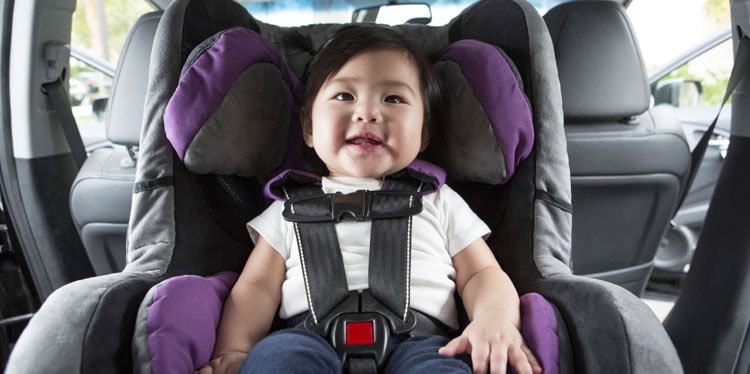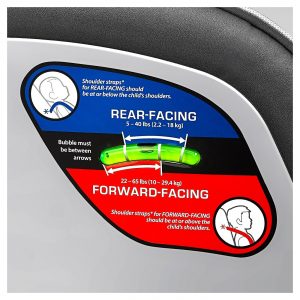Getting from here to there: updates and resources for child passenger safety

Did you know 4 out of 5 car seats are installed or used incorrectly? Keeping up with the changes and recommendations for child passenger safety can be a challenge. Here are a few current recommendations and resources for keeping your child safe when traveling around Minnesota.
Rear-facing versus forward-facing positioning
This fall the American Academy of Pediatrics (AAP) updated their recommendations to promote keeping children in the rear-facing position for as long as possible. As infants and young children are at increased risk for head and spinal cord injury due to their relatively large head and developing musculoskeletal system, a rear-facing position reduces this risk by providing more head and back support in the event of a crash.2 Therefore, instead of an age limit, the AAP now recommends children be rear-facing until they meet the highest rear-facing weight or height limit allowed by the manufacturer of their car seat.1
This means that after reaching the limits of a rear-facing only car seat (the seat with a handle that attaches to a base) a child should switch to a convertible car seat and remain in the rear-facing position until the limits are met. With this change, many parents will find that their child’s feet will eventually reach the seat, this is not a concern as they can bend and reposition their legs easily to ride comfortably.
Once a child reaches the weight or height limit of the rear-facing position in their convertible car seat, the child should switch to a car seat in the forward-facing position with a harness (convertible or combination car seat) until they reach the height or weight limit allowed by the manufacturer.1
See this example of a manufacturer’s weight limits and positioning guidance on a convertible car seat:

Belt-positioning booster seat (high-back or backless)
After reaching the height or weight limit in the forward-facing harnessed car seat, a child should transition to a booster seat using the lap and shoulder seatbelt until the lap and shoulder belt fits correctly, typically when a child is at least 4 feet 9 inches, and are between 8 and 12 years old.1
Riding in the front passenger seat
The AAP recommends that children under 13 years of age continue to ride in the back seat of vehicles even when they have met the height limit for using only the lap and shoulder seat belt as they are at increased risk for injury from airbag deployment.2
Car seat safety checks
Meet with a certified instructor in your community to ensure your child’s car seat is installed properly and to learn safe transportation practices. You can find an instructor in your area through the MN Department of Public Safety on the “Find Car Seat Checks” webpage.3 Car seat classes are available at MVNA, free with certain insurance coverage.
Tips for winter travel5
- Do not put bulky/thick clothing or jackets on before buckling a child into the car seat because these may not allow the straps to be tight enough to secure your child in an accident. Instead, dress the child in a few thin layers and use a blanket or jacket over the straps to keep your child warm.
- Use hats, mittens, socks, and footwear to help keep your child warm.
- Use winter covers for car seats that only go over the top of the car seat; do not use covers that have a layer that goes under the child when in the car seat.
Resources for more details about child car seats and safe transportation
- Minnesota Department of Public Safety, Child Passenger Safety
- Car Seats: Information for Families from Healthychildren.org
- Winter Car Seat Safety Tips from the AAP from Healthychildren.org.

Lauren Petersen, CNP, DNP, MPH is a certified Pediatric Nurse Practitioner at Hennepin Healthcare and splits her time between the Clinic & Specialty Center in Minneapolis and our Brooklyn Park Clinic.
Reference List:
- Durbin DR, Hoffman BD, AAP COUNCIL ON INJURY, VIOLENCE, AND POISON PREVENTION. Child Passenger Safety. Pediatrics. 2018; 145(5):e20182460
- Durbin DR, Hoffman BD, AAP COUNCIL ON INJURY, VIOLENCE, AND POISON PREVENTION. Child Passenger Safety. Pediatrics. 2018; 145(4):e20182461
- Find Car Seat Checks. Minnesota Department of Public Safety: Office of Traffic Safety. Accessed October 10, 2018.
- Car Seat: Information for families. Updated August 30, 2018. Accessed October 10, 2018.
- Winter Car Seat Safety Tips from the AAP. Updated December 14, 2015. Accessed October 10, 2018.

